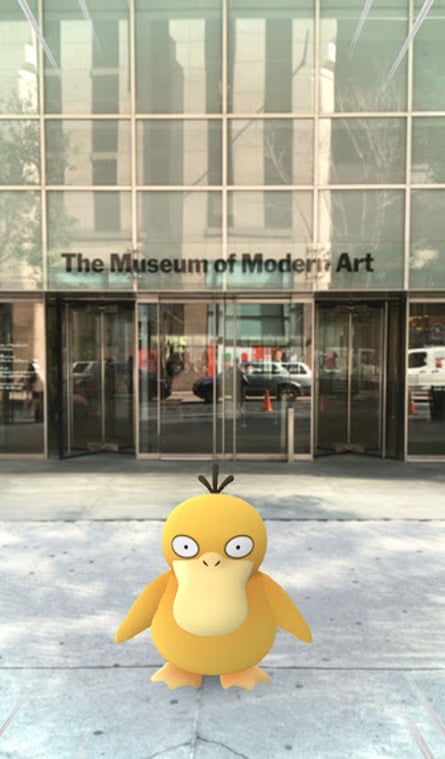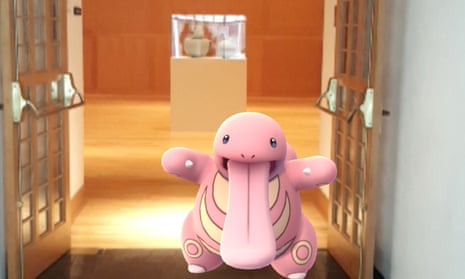Summer is a tough time to get paying museumgoers through the doors – but this year, there’s an extra incentive. Art museums like the Whitney and the Museum of Modern Art in New York are jumping on the Pokémon Go bandwagon and helping players of the augmented reality game “catch ’em all”.
Just as local businesses have jumped on the bandwagon to get new customers, museums are jumping on board to attract young players and boost ticket sales from Los Angeles to New York, Texas and Boston.
Pokémon Go, the mobile app released earlier this month, boasts 26 million daily active players in the US alone. The game, which has generated over $14m and is available in 25 other countries, allows players to catch cartoon monsters on their smartphones, using the real world as a backdrop for the augmented reality game.
Gamers are out pounding the pavement through a GPS-programmed map, but it’s not without controversy – players have walked off cliffs, found dead bodies and caused a stampede at Central Park.
“Pokéstops” are places where gamers catch characters and gain points. Several of these checkpoints are now at museums.

The MoMA has two Pokéstops, including one right at the front gates, showing that some players need not enter the museum to play the game. However, other characters are waiting inside the galleries at the current Tony Oursler and Rachel Harrison exhibitions.
At the Philadelphia Museum of Art, there are eight Pokéstops around the building. The museum is “devoted to the idea of creative play”, according to its associate director of digital marketing, Chessia Kelley, who helped create a Pokémon meet-up during the museum’s “pay what you wish” hours.
Apparently, the decision wasn’t meant to drive sales – rather to “attract visitors during an accessible time-period when users are encouraged to casually browse the galleries”, said Kelley.
The numbers show an improvement: attendance during the meet-up was up 13% from the previous week, 25% from this time last year and 37% higher than the average during the first quarter of last year .
But it’s easy to spot the difference between thoughtful museumgoers and hungry gamers hunting for Pokéstops – who could otherwise be perceived as zombies with smartphones mindlessly trailing through the corridors with screen tunnel vision. In other words, is the art merely a backdrop, seen only through a handheld device?
This article includes content provided by Instagram. We ask for your permission before anything is loaded, as they may be using cookies and other technologies. To view this content, click 'Allow and continue'.
“Many gathered in the galleries where Pokéstops were baited and spent several minutes there waiting to see what they could collect before moving to the next stop,” said Kelley.
Instead of just planting gamer bait around art, other museums are motivated by different reasons to partake in the craze. The Morikami Museum and Japanese Gardens in Delray Beach, Florida, jumped on the bandwagon because of the cultural connection, as Pokémon was created by the Japanese game designer Satoshi Tajiri in 1995.
“We felt we had a direct cultural connection to the Japanese franchise,” said Monika Amar, who works in marketing at the museum, which has 15 Pokéstops.
“Our attendance has spiked in the days since the application was first released,” said Amar. “We’ve found that once people come to play Pokémon Go, they return to experience the museum and gardens and for the opportunity to ‘catch ’em all’ in a picturesque landscape.”
But it isn’t all so Zen. On the Morikami fanpage, people posted photos of their vandalized garden. Some Pokémon Go users carved their team names into trees – one reading “Team Instinct Rocks” – and were caught climbing trees.
That angered one museumgoer with an annual membership to the Morikami gardens, Kandi Kalistar.
“I’m so appalled my serene quiet place is marked up by idiots chasing Pokémon,” said Kalistar in one of her YouTube videos. “I’m disgusted by the lack of courtesy of these kids, but it’s not only kids. Have respect for the environment around you.”
The United States Holocaust Memorial Museum in Washington also asked the game developers Niantic Labs to remove the Pokéstops from the museum when staff realised that some users would be tempted to play the game there.
“Playing Pokémon Go in a memorial dedicated to the victims of Nazism is extremely inappropriate,” said Andrew Hollinger, the museum’s communications director. “The museum encourages visitors to use their phones to share and engage with museum content while here. Technology can be an important learning tool, but this game falls far outside of our educational and memorial mission.”
For the McNay Art Museum in San Antonio, Texas, the game is a better fit. “We’re hopeful that Pokémon Go will attract these young visitors, while helping promote free admission for 19 and under,” said Julie Ledet, the museum’s communications officer.
“We are definitely considering the possibilities of what kind of engagement this could create with new visitors and definitely a younger generation of museumgoers.”
Some characters are hidden in the museum’s courtyard, while others are situated by famous artworks by Pablo Picasso, Vincent van Gogh and Claude Monet. “Pokéstops are historical and cultural markers,” Ledet said. “They give players an extra incentive to visit these spaces.”
However, Pokéstops are now the most popular visiting spots in the museum, meaning that other artworks may lose out. Kiki Smith’s Woman and Sheep marks one of the eight Pokéstops on museum grounds. “We have a fun joke running on the museum’s Snapchat that the Auguste Rodin sculpture Head of Pierre de Wissant is bummed that he wasn’t selected as a Pokéstop, too,” she said.










Comments (…)
Sign in or create your Guardian account to join the discussion